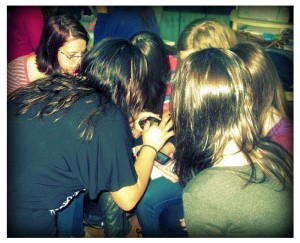BYOT: No Internet Access, No Problem

cross-posted at teacherrebootcamp.com
Part of the Mobile Learning Series!
“The principle goal of education in schools should be creating men and women who are capable of doing new things, not simply repeating what other generations have done.” ~ Jean Piaget
I have been traveling throughout Slovenia and Croatia for the past month training teachers in integrating Bring Your Own Technology (BYOT) effectively with their classes. I was very fortunate to have the opportunity to teach various classes of teens throughout the two countries to show teachers how BYOT works. For the days I was teaching the students, these schools lifted their policies and allowed the students to use their devices as a way of getting technology in the schools. The teachers wanted to see BYOT in action, especially with students who were never allowed to use their mobile devices or other technologies before for learning. BYOT was a great option because many of these students would not usually be able to learn with various technologies in schools if they didn’t bring them in. I’ve posted a video created by Marijana Smolcec who filmed me working with the students at her school in Ogulin, Croatia.
10 Offline Activities with Mobile Devices
One problem with integrating most technology is that schools and teachers rely too much on Internet access. We forget that even without the Internet, laptops and mobile devices are very powerful learning tools. Simple cell phones come with the ability to create videos, take photos, record audio, and take notes. Students carry these powerful learning tools in their pockets and don’t realize the learning potential, because we do not open their eyes to it. We can get our students to do so much with these tools while they are riding the bus, walking home, visiting their favorite places, etc. Here are a few ideas of the many, I do with students that do not require “a class” Internet connection:
- Commercial Ads- students often create short video commercials in groups. We have created commercials with invented apps and objects. We also did a project where we observed the stereotypes in commercials and recreated them without the stereotypes.
- Previews- students create a movie preview of a book they enjoyed and want to see adapted to film.
- Memes- students create videos of various memes such as a flash mob, the Harlem Shake, or lip dubs.
- Digital Stories- students work in groups to create a digital story. There are various video editing apps on any device that once downloaded work offline. For example, students can create videos with Sockpuppets, Puppet Pal, VidEditorFree, etc.
- Show N Tell with a Cell- students show pictures they took on their devices to their peers and have a discussion of where they took the picture, what it is about, etc. You can give students topics. For example, if you teach math, you can tell them to bring in an image that represents various geometric shapes. If you teach science, the image can represent a concept such as centrifugal force.
- Show N Tell Image Story- a follow-up activity is to have the students take the images from their group and create a story with these images.
- Visual Vocabulary- each week the students take photos or record a video representing the concepts, vocabulary, and topics we are covering. They upload these collected artifacts to a class laptop via flash stick. If Internet access is available, they can upload the videos or images to a class Flickr account via email. Check out an example here, http://www.flickr.com/photos/shellyterrell/tags/restaurant1a/
- Howto Videos- each learner can take a concept we are learning and teach us about it or create a how to video on something they are great at. Have them create a video cooking a recipe or instructing how to play their favorite video games. Cooking often involves vocabulary, math, and science lessons.
- Field Observations- students observe an object, environment, or animal for a series of weeks. They take images, video, and journal about this observance daily. At the beginning, they make predictions about this observance. We did this with spiders and their webs.
- Reporting the News- students work in pairs or groups. Assign them a section from the text or item they are covering and have them create a short news segment about the topic.
More Resources
Tools and ideas to transform education. Sign up below.
- Check out my mobile learning posts, presentations, free ebooks and more, http://teacherrebootcamp.com/free-ebooks/mobile-learning-50-resources-tips
- Slide Presentation: 10 Offline Ideas with a Mobile Device
- Slide Presentation: We Like to Move It! Active Learning with Mobile Devices
- Slide Presentation: 15 Offline Activities to do With an iPad
Shelly Terrell is an education consultant, technology trainer, and author. Read more at teacherrebootcamp.com
